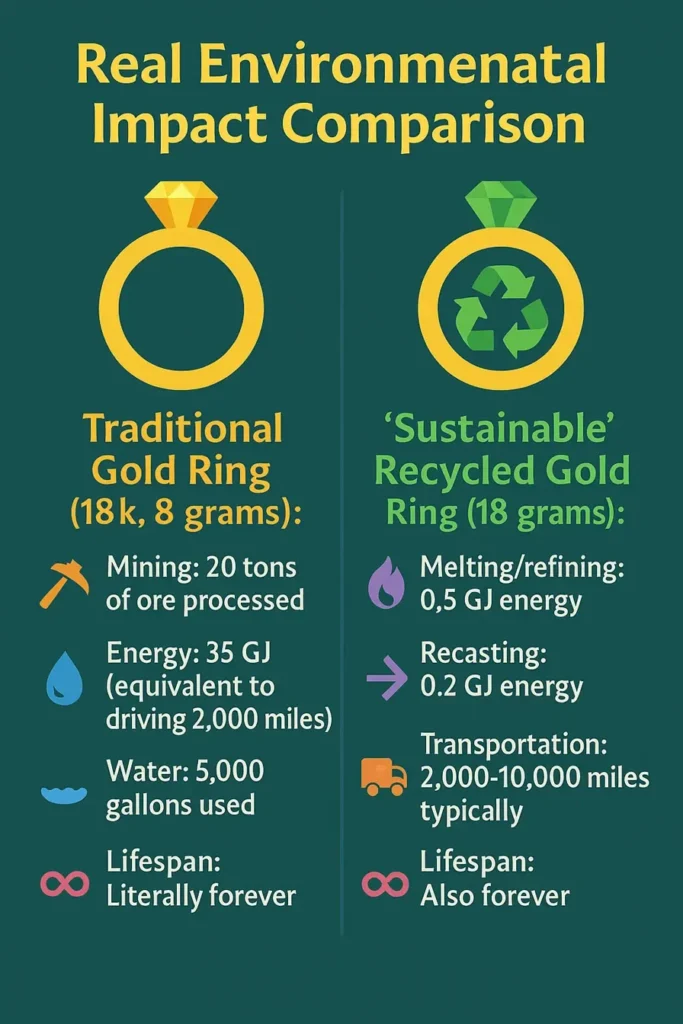
A tungsten ring mined in China, shipped to India for cutting, sent to the US for finishing, packaged in a bamboo box, and marketed as “sustainable” because the box biodegrades. That’s the jewelry industry’s version of environmental responsibility right now.
The sustainable ring movement started around 2018 when lab diamonds hit mainstream. Suddenly every jeweler discovered ethics. Rings that were just rings became “eco-conscious choices.” Prices jumped 40%. The bamboo box costs $2 to make but adds $75 to the price tag.
How This Marketing Angle Emerged
2016: Leonardo DiCaprio invests in Diamond Foundry (lab diamonds)
2017: Millennials start refusing traditional diamonds
2018: “Blood Diamond” documentary gets Netflix revival
2019: Every jewelry brand launches a “sustainable” line
2020-2025: The word sustainable appears on 78% of men’s ring listings
Nobody was asking for sustainable rings before marketers told them to care. Men bought tungsten because it didn’t scratch. Titanium because it was light. Now they buy the same metals with different stories attached.
The Actual Comparison Nobody Makes
| Aspect | “Sustainable” Rings | Traditional Rings | The Reality |
|---|---|---|---|
| Material Source | “Recycled gold” from old jewelry | Newly mined gold | Both require the same energy to melt and reform |
| Lab Diamonds | “Zero environmental impact” | Mined diamonds “destroy ecosystems” | Lab diamonds use 250 kWh per carat – that’s 3 months of home electricity |
| Tungsten Carbide | “Ethically sourced tungsten” | Regular tungsten | 85% comes from the same Chinese mines either way |
| Wood Inlays | “Sustainably harvested wood” | Regular wood | 0.5 grams of wood in a ring – environmental impact: zero |
| Carbon Footprint | “Carbon neutral shipping” | Standard shipping | They buy carbon credits for $0.15, charge you $15 extra |
| Packaging | Bamboo or recycled cardboard | Velvet or leather box | Bamboo box travels 8,000 miles from Asia |
| Price Premium | +30-60% for “sustainability” | Base price | You’re paying for marketing, not materials |
| Durability | Same as traditional | Same as sustainable | Metal is metal |
| Resale Value | 20-30% of purchase price | 40-50% of purchase price | “Sustainable” branding doesn’t transfer to secondhand market |
What “Sustainable” Actually Means in Ring Marketing
- Recycled Gold: The gold in your “sustainable” ring was probably mined 50 years ago. Maybe 500. Gold doesn’t degrade. Every piece of gold ever mined still exists. Your wedding ring could contain atoms from Egyptian tombs. Calling it “recycled” is like calling tap water “recycled rain.”
- Lab-Created Diamonds: Require massive amounts of electricity. The machines run at 1,500°C for weeks. Most labs operate in countries using coal power. A lab diamond from India (60% of production) has a larger carbon footprint than a mined diamond from Canada.
- Alternative Materials: Silicone rings biodegrade in “only” 20-30 years. Your great-grandkids will still find that ring in a landfill. Wood rings use more epoxy resin (petroleum product) than wood. Meteorite rings – because nothing says sustainable like harvesting space rocks.

The Lab Diamond Disruption
Lab diamonds changed everything, but not how you’d expect.
De Beers fought them for decades. Called them fake. Said they had no value. Then in 2018, De Beers launched Lightbox – their own lab diamond brand. Suddenly lab diamonds were real diamonds. Just cheaper ones.
The sustainability angle was retroactive justification. Lab diamonds succeeded because:
- 30-40% cheaper than mined
- Physically identical
- No wife asking about the Four C’s
- Could afford 2 carats instead of 1
Men didn’t buy them to save the planet. They bought bigger diamonds for less money. Marketers added the environmental story later.
Real Environmental Impact Comparison

Traditional Gold Ring (18k, 8 grams):
- Mining: 20 tons of ore processed
- Energy: 35 GJ (equivalent to driving 2,000 miles)
- Water: 5,000 gallons used
- Lifespan: Literally forever
“Sustainable” Recycled Gold Ring (18k, 8 grams):
- Melting/refining: 0.5 GJ energy
- Recasting: 0.2 GJ energy
- Transportation: 2,000-10,000 miles typically
- Lifespan: Also forever
The recycled version is better. About 95% better. But here’s what they don’t mention: keeping your dad’s old ring is 100% better. Buying nothing is infinitely better. A silicone ring for $12 beats both if we’re actually talking sustainability.
Why Men Actually Buy These Rings
Focus groups reveal the truth:
What men say: “I care about the environment and ethical sourcing.”
What men mean:
- “My fiancée’s friends will judge us if it’s not sustainable”
- “I can get a lab diamond 40% cheaper”
- “The Instagram post looks better with #sustainable”
- “I honestly don’t know the difference but sustainable sounds responsible”
What actually happens: They wear it for two years then upgrade to whatever’s trending. The “sustainable forever ring” joins the drawer of abandoned watches.
The Brands Profiting from Confusion
- Brilliant Earth ($200M revenue): Sells “Beyond Conflict Free” diamonds. Beyond conflict free isn’t a certification. It’s marketing copy they invented. Their recycled gold comes from the same refineries everyone uses.
- Manly Bands ($50M revenue): Sells rings made from “Jack Daniel’s whiskey barrels” and “NASA space shuttles.” A whiskey barrel ring is wood with resin. The NASA metal? Surplus aerospace aluminum anyone can buy.
- Raw Elements ($5-10M revenue): Markets rings carved from “ancient Welsh slate” and “Irish bog oak.” The slate is quarry waste. The bog oak is literally dead trees from swamps. Both marketed as premium materials because they sound exclusive.
The Inconvenient Numbers
Sustainable ring market growth:
- 2018: $450 million
- 2020: $890 million
- 2022: $1.6 billion
- 2024: $2.3 billion
- 2026 (projected): $3.8 billion
Traditional ring market growth:
- 2018: $12 billion
- 2024: $13 billion
Sustainable rings aren’t replacing traditional ones. They’re a new category targeting people who wouldn’t have bought expensive rings otherwise. It’s market expansion disguised as market disruption.
What Actually Matters for Ring Sustainability
- Durability: A tungsten ring lasts 100 years. A silver ring needs replating every 5 years. Which is more sustainable?
- Repairability: Gold can be resized, repaired, melted, reformed infinite times. Tungsten cracks? Garbage.
- Local Manufacturing: A ring made by a local jeweler from existing gold beats any “sustainable” ring shipped from overseas.
- Actual Usage: The most sustainable ring is the one you actually wear. That $2,000 sustainable ring you never wear is less sustainable than a $20 steel ring worn daily.
The Comparison That Matters
Option A: Sustainable™ Ring
- Recycled platinum band: $2,400
- 1.5 carat lab diamond: $3,200
- Sustainable packaging: Included
- Carbon offset shipping: Included
- Total: $5,600
- Feel-good factor: High
- Actual environmental benefit: Marginal
Option B: Traditional But Smarter
- Vintage ring from estate sale: $2,000
- Professional cleaning/restoration: $200
- New box if needed: $50
- Total: $2,250
- Feel-good factor: Medium
- Actual environmental benefit: Maximum (truly reused)
Option C: Actually Sustainable
- Titanium band from local jeweler: $300
- No diamonds: $0
- Regular box: Included
- Total: $300
- Feel-good factor: Low
- Actual environmental benefit: High
The Truth About Consumer Adoption
People buy sustainable rings for three reasons, ranked by actual importance:
- Price – Lab diamonds cost less
- Social pressure – Partners prefer the sustainable story
- Genuine concern – Maybe 5% actually research the impact
Instagram posts tagged #sustainablering: 847,000 Instagram posts showing the same rings after 5 years: 1,200
The sustainable ring movement is jewelry’s version of greenwashing. Take existing products, add environmental buzzwords, increase prices, profit from consumer guilt.
What This Means for Buyers
If you actually care about sustainability:
- Buy vintage or inherit family rings
- Choose durable materials over marketed ones
- Skip diamonds entirely (lab or mined)
- Buy from actual local craftsmen, not “local” brands that manufacture overseas
If you just want a nice ring:
- Buy what you like
- Ignore the sustainability marketing
- Lab diamonds are fine (cheaper, identical)
- Traditional rings are also fine
If you want the marketing story:
- Sustainable brands will happily take your premium
- The bamboo box photographs well
- Your friends will approve
- The ring itself is probably fine
The joke is that rings are inherently sustainable. Gold doesn’t expire. Diamonds don’t rot. A ring from 1920 works exactly like one from 2024. The least sustainable part of any ring is convincing people they need new ones.
Marketing created a problem (traditional rings harm the environment) then sold the solution (sustainable rings that are marginally better). The real solution was always simpler: buy less, buy used, or don’t buy at all. But that doesn’t generate $2.3 billion in revenue.
Every “sustainable” ring company is a regular ring company with better copywriting. The metal comes from the same places. The manufacturing uses the same processes. The only difference is the story they tell and the premium they charge for telling it.
